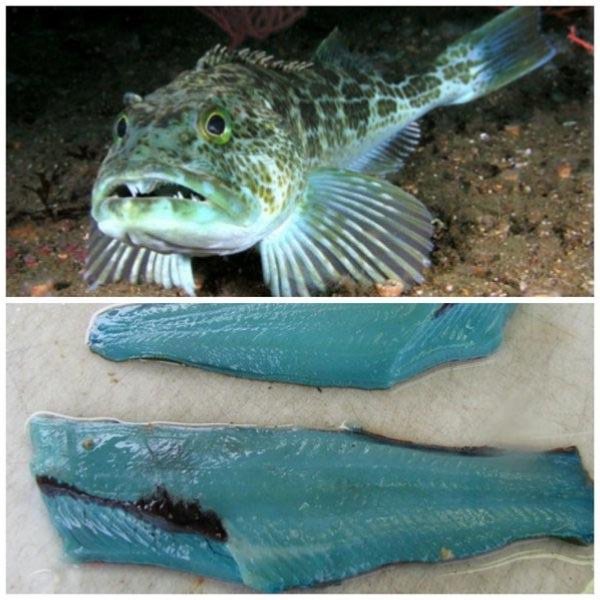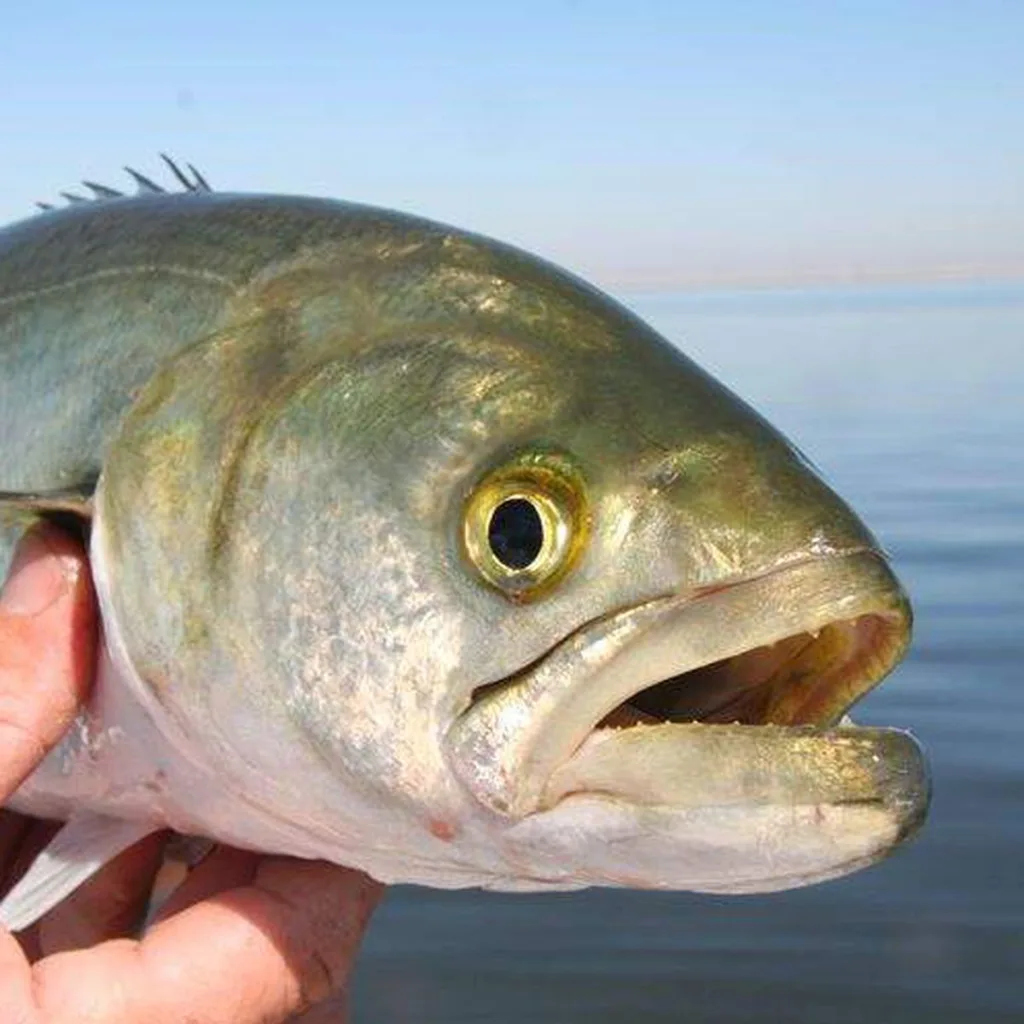When we think of fish, we often imagine a white or pinkish flesh. However, there are some fish species that have blue meat, which is quite a unique and striking characteristic. In this blog post, we will take a closer look at some of the fish species that have blue meat, what causes this coloration, and how to prepare and cook them.
One of the most well-known fish species with blue meat is the lingcod. This fish is found in the North Pacific Ocean and can grow up to 5 feet in length. Lingcod has a bluish-green hue to its flesh, which is caused by a bile pigment called biliverdin. It is still unclear how this pigment gets into the fish’s tissues and flesh, and why only some lingcod turn this striking shade.
Another fish species with blue meat is the rock greenling. This fish is found along the rocky coasts of the Pacific Northwest and can grow up to 20 inches in length. Rock greenling has a blue tint to its flesh, which is also caused by biliverdin.
Kelp greenling is another fish species with blue meat. This fish is found in the kelp forests along the Pacific coast and can grow up to 2 feet in length. Kelp greenling has a bluish-green hue to its flesh, which is also caused by biliverdin.
Cabezon is a fish species found along the Pacific coast of North America, from Alaska to Baja California. This fish can grow up to 3 feet in length and has a bluish-green tint to its flesh, which is also caused by biliverdin.
If you are lucky enough to come across any of thse fish species with blue meat, you may be wondering how to prepare and cook them. The key to preparing bluefish is to make sure that it’s fresh. This is because bluefish tends to spoil quickly, and the blue coloration will fade as the fish ages. So, make sure to purchase your bluefish from a reputable fishmonger, and use it as soon as possible.
To prepare bluefish, start by scraping off the scales and removing the bones. Bluefish tends to have a dark meat, which some people find too strong and fishy. To tone down the fishy smell, you can soak the fish in milk for a few hours before cooking. This will also help to tenderize the flesh.
We find that bluefish is too oily to be fried and is at its best grilled, baked, broiled or smoked. You can add your favorite seasonings and marinades to enhance the flavor of the fish. Bluefish pairs well with citrus, herbs, and spices. You can also serve it with a side of fresh vegetables or rice.
Fish species with blue meat are a unique and intriguing part of the seafood world. Lingcod, rock greenling, kelp greenling, and cabezon are just some of the fish species that have blue meat. Biliverdin is the pigment responsible for the blue coloration, but how it gets into the fish’s tissues and why only some fish are affected is still a mystery. If you are lucky enough to come across bluefish, make sure to prepare it fresh and experiment with different cooking methods and seasonings to enhance its unique flavor.
Types of Fish with Blue Meat
There are several types of fish that have blue meat. One of the most commonly known is the lingcod, which is a popular fish found in the Pacific Ocean. Lingcod have a distinctive blue-grey coloration to their meat, which is caused by a compound called myoglobin. This compound is found in high concentrations in the muscles of fish that are active swimmers, like lingcod.
Other fish that can have blue meat include rock greenling, kelp greenling, and cabezon. These fish are also found in the Pacific Ocean and have a similar blue-grey coloration to their meat. The blue color of their meat is not harmful and is actually considered a delicacy in some cultures.
It is important to note that not all fish have blue meat, and the color of a fish’s meat can vary depending on factors such as diet, age, and species. If you are unsure about the color of a paticular fish’s meat, it is always best to consult a fishmonger or other seafood expert before purchasing or consuming it.

The Mystery of the Blue Fish Meat
Fish meat can appear blue due to the presence of a pigment called myoglobin. Myoglobin is a protein that stores oxygen in the muscle cells of animals, including fish. When fresh fish is caught and exposed to air, the myoglobin can react with oxygen, causing it to turn a bluish-purple color. This is why some fish, such as tuna and swordfish, have a deep blue coloration when freshly caught.
However, the blue color of fish meat is not always due to myoglobin. In some species, such as the ling cod, the blue coloration is the result of a bile pigment called biliverdin. Biliverdin is a breakdown product of hemoglobin, the protein that carries oxygen in red blood cells. It’s not entirely clear how biliverdin causes blue coloration in fish, or why it only affects some individuals.
In addition to myoglobin and biliverdin, other factors can also contribute to the color of fish meat. For example, the diet of the fish can affect the color of its flesh. For instance, salmon that eat a diet rich in krill and other crustaceans will have a deeper red color due to the presence of a carotenoid pigment called astaxanthin.
The blue color of fish meat can have various causes, but it’s oftn due to the presence of pigments such as myoglobin or biliverdin. The exact mechanisms behind these pigments and their effects on fish coloration are still being studied by scientists.
The Mystery of the Blue Lingcod Meat
Lingcod meat is not always blue, but some lingcod specimens do have blue meat. According to marine biologist Richard Love, a pigment called biliverdin is responsible for turning the blood serum of these fish their stunning color. Biliverdin is a bile pigment that is found in the liver and sometimes in the muscle tissues of certain fish species. However, it is still unclear how this pigment gets into the tissues and flesh of the fish, or why only some lingcod turn this striking shade. Scientists are still investigating these mysteries to fully understand the phenomenon of blue lingcod meat.
The Edibility of Blue Meat Fish
Bluefish can be eaten. However, it is important to note that bluefish is a highly perishable fish and it should be consumed fresh. The flesh of bluefish is oily and has a strong flavor, whih some people find unpleasant. To prepare bluefish, first, remove the scales, bones, and dark meat. Soaking the fish in milk before cooking can help to reduce the fishy smell. Bluefish is not recommended to be fried due to its oily nature, but it is best cooked by grilling, baking, broiling, or smoking. When properly cooked, bluefish can be a delicious and nutritious addition to your diet.
Types of Blue Seafood
Blue seafood is not a common occurrence in the world’s oceans. However, the bluefish (Pomatomus saltatrix) is a well-known species of fish that has a blue-green back and silver sides. The bluefish is a pelagic fish that is found in temperate and subtropical waters around the world, excpt for the northern Pacific Ocean. It is a popular gamefish and is also caught for commercial purposes. Additionally, some species of crab, like the blue crab (Callinectes sapidus), have a bluish tint on their claws and carapace. However, it is important to note that the blue color in seafood can also be an indication of contamination or spoilage, so it is important to always purchase seafood from a trusted source and ensure that it is properly stored and cooked.

Is Tilapia a Type of Blue Fish?
Tilapia can be blue in color, but it is not a separate species known as “blue fish.” The blue tilapia, also known as Oreochromis aureus, is a species of tilapia that can have a bluish-gray coloration on its dorsal side. However, there are many other species of tilapia that come in a variety of colors such as red, yellow, and green. It is important to note that the coloration of tilapia can vary based on factors such as their location, diet, and breeding. So while some tilapia may appar blue, it is not a defining characteristic of the entire species.
Is Eating Blue Meat Healthy?
Blue meat, also known as rare or bleu meat, is a cooking term used to describe meat that is cooked very briefly, uually for only a minute or two on each side. The interior of the meat remains uncooked, giving it a blue or purple color.
Whether blue meat is good or not depends on personal preference. Some people enjoy the texture and flavor of this type of meat, while others find it too raw and prefer their meat to be cooked thoroughly.
From a health perspective, blue meat is generally safe to eat as long as it is fresh, high-quality meat and has been handled and cooked properly. The high-heat searing method used to cook blue meat kills any surface bacteria, making it safe to eat. However, it is important to note that consuming undercooked or raw meat carries a risk of foodborne illness, so it is important to be cautious and only eat meat that has been properly prepared.
Whether blue meat is good or not depends on personal preference. From a health standpoint, as long as it is fresh, high-quality meat that has been handled and cooked properly, it is safe to eat.
Fish With Purple Meat
The fish with purple meat is called Maguro, which is commonly known as Tuna or Akami in Japanese. Maguro is a type of bluefin tuna that has a deep reddish-purple color meat. The color of the meat is due to the high concentration of myoglobin, which is a protein that carries oxygen in the muscles. As the tuna grows up to 3 meters, the texture and flavor of the meat vary depending on where on the body the cut is takn from. The akami cut, which is taken from the fish’s back and sides, is quite lean, leading to a clean and slightly meaty flavor. Maguro is a popular sushi ingredient and often served raw or lightly seared. It is also used in other Japanese dishes such as sashimi, poke bowls, and grilled dishes.
The Significance of Blue Fish Bones
The blue-colored bone in fish is not a specific bone, but rther a general characteristic of the skeleton, scales, and bones of certain fish species. Two examples of fish that exhibit this bluish-green coloration are the garfish (Belone belone) and eelpout (Zoarces viviparus). This unique feature is caused by the presence of a blue pigment called guanine, which is found in the skin and scales of these fish. When light reflects off the guanine, it appears as a vibrant blue color, giving these fish an eye-catching and distinctive appearance. So, if you come across a fish with a bluish-green skeleton or scales, it’s likely to be a garfish or eelpout.

Source: independent.co.uk
The Mercury Content of Lingcod
Lingcod is considered to have elevated levels of mercury. This is because lingcod is a predatory fish that feeds on smaller fish that may contin mercury. Mercury is a toxic heavy metal that can accumulate in the tissues of fish, including lingcod. Therefore, it is recommended to consume lingcod in moderation to minimize the potential health risks associated with mercury exposure. It is important to note that the exact amount of mercury in lingcod can vary depending on factors such as the location of the fish and its diet. It is always best to consult with a healthcare professional if you have any concerns about consuming fish with elevated levels of mercury.
Is Eating Lingcod Healthy?
Lingcod is considered a healthy fish to eat. It is an excellent source of protein which helps in building and repairing tissues, promoting healthy bones, cartilage, skin, and blood. Additionally, lingcod is a rich source of omega 3 fatty acids which are essential for maintaining good heart health and lowering cholesterol levels. Omega 3 fatty acids have also been linked to a reduced risk of chronic diseases such as diabetes, cancer, and arthritis. Furthermore, lingcod is low in calories and fat, making it a great choice for people who are watching ther weight or trying to maintain a healthy lifestyle. incorporating lingcod into a balanced diet can provide many health benefits.
The Edibility of Blue Cod
Blue Cod is considered to be an excellent fish for eating due to its delicate salty-sweet flavour and unique light texture. It is highly prized in New Zealand, particulary amongst South Islanders where the species is most prevalent. Blue Cod is a wild-caught fish and is known for its firm flesh and flaky texture, making it perfect for a range of cooking methods including baking, grilling, and frying. It is also a versatile fish that pairs well with a range of flavours and ingredients. Blue Cod is a delicious and highly sought-after fish that is well worth trying if you get the chance.
Fish That Should Not Be Eaten
There are certain types of fish that are best avoided due to a variety of reasons. One such group of fish includes sharks, skates, and rays. These fish species are known to be high in mercury, which can have negative impacts on human health. In addition to this, consuming too many of these predatory fish can also have detrimental effects on ocean ecosystems. Therefore, it’s best to skip these fish and choose other options that are safer and more sustainable for both our health and the environment.

Source: bbc.com
Taste of Bluefish
Bluefish has a distinct, full flavor that is often described as rich, oily and meaty. Its texture is firm and dense, with large flakes that hold together well when cooked. The flesh is pinkish-gray and can vary in color depending on the age and size of the fish. Bluefish has a high oil content which gives it a robust flavor that some people find too strong. However, others appreciate its bold taste and consder it a delicacy. When cooked, bluefish is tender and moist, with a slightly sweet and nutty aftertaste. bluefish is a flavorful fish that can be enjoyed in a variety of ways, from simple preparations like grilling or broiling to more complex dishes that feature bold spices and herbs.
The Mercury Content of Blue Fish
Bluefish are high in mercury levels. Mercury is a toxic substance that can accumulate in fish and other seafood through various means such as pollution and other human activities. Bluefish are known to be particularly high in mercury compared to some other popular fish species. This means that consuming large amounts of bluefish can potentially lead to unhealthy levels of mercury in the body, which can cause serious health problems over time. Therefore, it is recommended to consume bluefish in moderation and to be aware of the potential risks associated with consuming fish that are high in mercury levels.
Conclusion
Fish with blue meat are not commonly found in most seafood markets. However, certain species such as lingcod, rock greenling, kelp greenling, and cabezon are known to have this unique characteristic. The blue color is believed to be the result of a bile pigment called biliverdin, althouh the exact process of how it colors the fish remains a mystery to biologists. When preparing bluefish, it is crucial to ensure that it is fresh and free from scales, bones, and dark meat. Soaking it in milk can also help reduce the fishy smell. While it may be too oily to fry, bluefish can be grilled, baked, broiled, or smoked to showcase its flavorful and visually striking blue meat. fish with blue meat are a fascinating aspect of the seafood world that continue to intrigue scientists and delight seafood enthusiasts.
